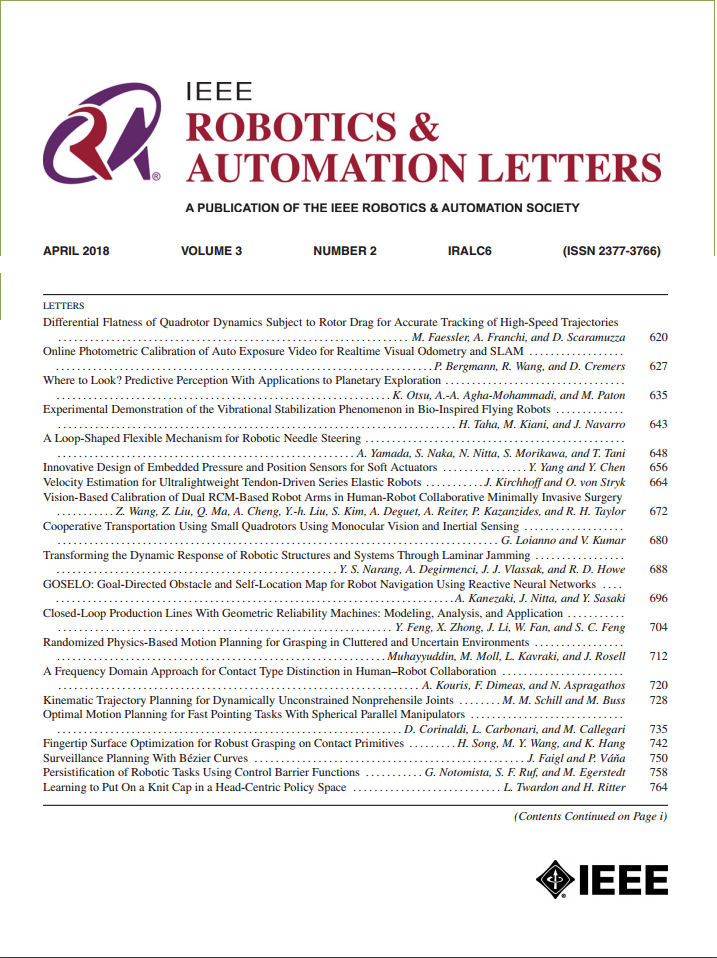Structure-Preserving Model Order Reduction of Slender Soft Robots via Autoencoder-Parameterized Strain
IF 5.3
2区 计算机科学
Q2 ROBOTICS
引用次数: 0
Abstract
While soft robots offer advantages in adaptability and safe interaction, their modeling remains challenging. This letter presents a novel, data-driven approach for model order reduction of slender soft robots using autoencoder-parameterized strain within the Geometric Variable Strain (GVS) framework. We employ autoencoders (AEs) to learn low-dimensional strain parameterizations from data to construct reduced-order models (ROMs), preserving the Lagrangian structure of the system while significantly reducing the degrees of freedom. Our comparative analysis demonstrates that AE-based ROMs consistently outperform proper orthogonal decomposition (POD) approaches, achieving lower errors for equivalent degrees of freedom across multiple test cases. Additionally, we demonstrate that our proposed approach achieves computational speed-ups over the high-order models (HOMs) in all cases, and outperforms the POD-based ROM in scenarios where accuracy is matched. We highlight the intrinsic dimensionality discovery capabilities of autoencoders, revealing that HOM often operate in lower-dimensional nonlinear manifolds. Through both simulation and experimental validation on a cable-actuated soft manipulator, we demonstrate the effectiveness of our approach, achieving near-identical behavior with just a single degree of freedom. This structure-preserving method offers significant reductions in the system degrees of freedom and computational effort while maintaining physical model interpretability, offering a promising direction for soft robot modeling and control.基于自编码器参数化应变的细长软机器人保结构模型降阶
虽然软体机器人在适应性和安全交互方面具有优势,但它们的建模仍然具有挑战性。这封信提出了一种新颖的,数据驱动的方法,用于在几何可变应变(GVS)框架内使用自编码器参数化应变来降低细长软机器人的模型阶数。我们使用自编码器(ae)从数据中学习低维应变参数化以构建降阶模型(ROMs),在显著降低自由度的同时保留了系统的拉格朗日结构。我们的比较分析表明,基于ae的rom始终优于适当的正交分解(POD)方法,在多个测试用例的等效自由度下实现更低的误差。此外,我们证明了我们提出的方法在所有情况下都可以实现高阶模型(HOMs)的计算加速,并且在匹配精度的情况下优于基于pod的ROM。我们强调了自编码器固有的维数发现能力,揭示了自编码器通常在低维非线性流形中运行。通过对缆索驱动软机械臂的仿真和实验验证,我们证明了我们的方法的有效性,仅用单个自由度就实现了几乎相同的行为。这种保持结构的方法在保持物理模型可解释性的同时显著降低了系统自由度和计算量,为软机器人建模和控制提供了一个有前途的方向。
本文章由计算机程序翻译,如有差异,请以英文原文为准。
求助全文
约1分钟内获得全文
求助全文
来源期刊

IEEE Robotics and Automation Letters
Computer Science-Computer Science Applications
CiteScore
9.60
自引率
15.40%
发文量
1428
期刊介绍:
The scope of this journal is to publish peer-reviewed articles that provide a timely and concise account of innovative research ideas and application results, reporting significant theoretical findings and application case studies in areas of robotics and automation.
 求助内容:
求助内容: 应助结果提醒方式:
应助结果提醒方式:


